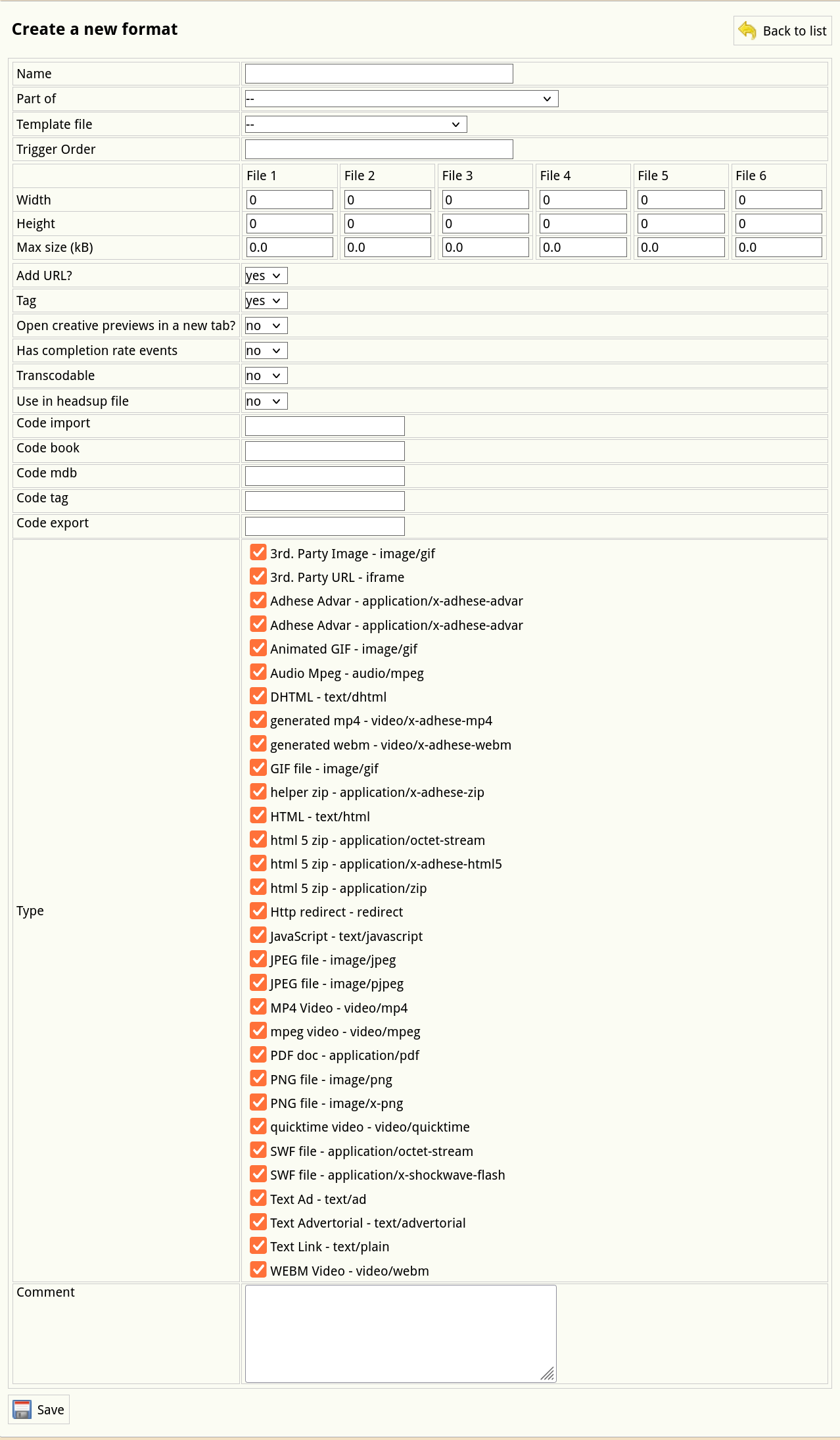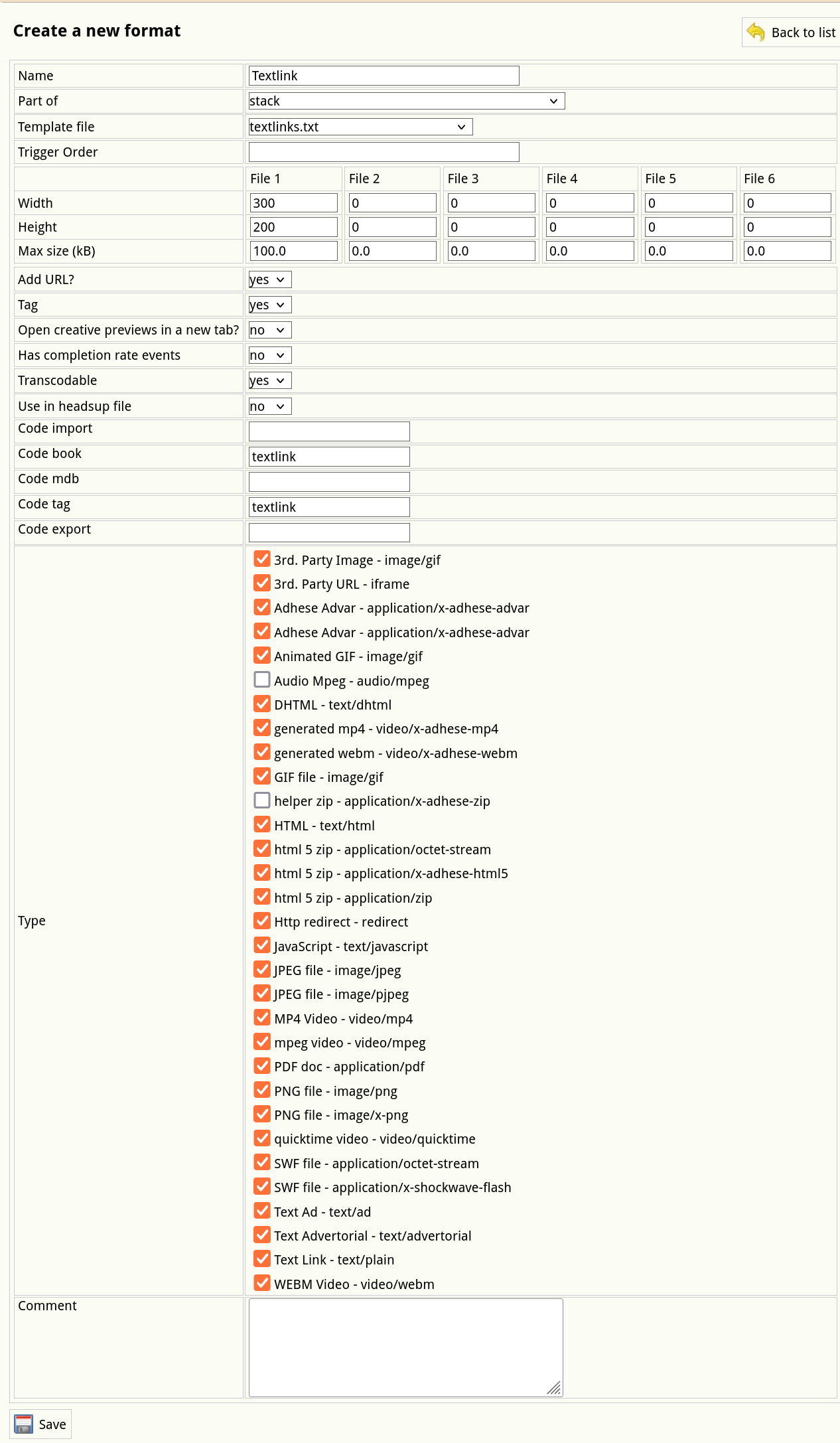Formats
A format specifies the requirements, such as file size and dimensions, that a creative must meet to prevent errors when uploading the creative file. A format does not have to be limited to online banner ads; it can also be a native ad or a video ad. All formats are acceptable as long as they fit within your inventory structure, website design and strategy.
Refer to the Appendix Online advertising formats for a definition of the most important formats and a representation within their environment. The overview is not exhaustive. A publisher can implement custom formats as well.
Create a format
The Formats screen consists of a table with three columns:
- The No column displays the ID of the format.
- The Format column shows the name of the format and its dimensions.
- The Template file column shows the template file that belongs to the format.
To create a new format:
-
Click Admin in the left navigation menu. This opens the Administration screen.
-
Click the Create a format button. This opens the Create a new format screen.

-
Enter a name in the Name field. Choose a clear and logical name, such as Leaderboard or Interstitial.
-
Determine whether the format is part of a stack from the Part-of drop-down.
A Stack format sends a list of ads that are available for display for that position. A stack is always a client-specific implementation.
-
(Optional) Select a JavaScript template file in the Template file drop-down. Refer to Templates for more information about template files.
-
If you choose to deliver multiple campaign bookings simultaneously (see Delivery multiples), you will need to specify the order of the formats on the web page. In the Trigger Order field, enter a number that indicates the position of the format within the sequence of formats.
-
Enter the dimensions of the format in pixels in the Width and Height fields.
You can configure a format to contain up to six images.
-
Enter the maximum file size of the format in kiloBytes in the Max size (kB) fields.
-
Skip the next property (Add URL?) as it is of no significance anymore.
-
In the Tag drop-down:
-
Select yes if the format is the main format.
Do not forget to enter a code tag in the Code tag field (step 15), as a new tag is necessary for the main format.
-
Select no if the format is a subformat.
Do not forget to refer to the main format in the Code book field (step 13).
-
-
Open creative previews in a new tab? The default setting is no. When set to yes, the preview of a creative is shown in a new tab.
-
Select yes or no from the Has completion rate events drop-down to activate video reporting for the new format.
-
The transcodable option is currently not supported. Leave it on no.
-
If the format will be used in Digital Out of Home (DOOH) positions, assets can be pre-loaded and cached by selecting yes in Use in headsup file (if the headsup endpoint is configured).
-
(Optional) Specify the foreign key of the format in the Code Import field to link Adhese to an existing external CMS.
-
Enter the name of the tag variable in the Code book field. If the format is a subformat, enter the tag code of the main banner. (Optional)
-
The Code MDB field is deprecated
-
Enter the name of the tag variable in the Code tag field. The code tags themselves are usually defined in the setup stage.
A code tag is only required if the format is the main format (step 11). For example, if your main format runs on the BANNER tag, the tag code is BANNER.
-
(Optional) Provide a key in the Code export field to establish a link with an external database.
The following table gives a few examples of completing the Code tag and Code book input fields for main and sub formats.
| Format name | Format type | Code tag | Code book |
| Leaderboard | Main format | leaderboard | leaderboard |
| Homepage takeover (leaderboard + wallpaper) | Sub format | leaderboard | |
| Medium rectangle | Main format | rectangle | rectangle |
| Large rectangle | Sub format | rectangle |
- Specify the Type of the format, such as a third-party URL or image, video, animated GIF, or text ad. As a format can take many forms, you can select more than one type.
- (Optional) Enter a comment in the Comment field.
- Click the Save button beneath the form to save your new format.
You must save the main format again after creating a new subformat. For all existing main format positions, subformat positions will also be available on the booking screen.
Edit a format
To edit a format:
- Go to the Administration screen. Click Admin in the left navigation menu.
- Click Formats.
- In the list of formats, click the format's name or click the edit icon
 for the format you want to edit. The Edit template screen opens:
for the format you want to edit. The Edit template screen opens:

- Change any of the format’s details.
- Click Save.
Stacked format
A Stack format sends a list of ads available to display for that position. The client (browser) decides which ad(s) to display. An example of a stacked format is a text link ad.
To create a stacked format, add a new format:
- Click Admin in the left navigation menu. This opens the Administration screen.
- Click Formats. The Formats screen opens:

- Click the Create a format button. The Create a new format screen opens:

- Define the following properties that are necessary for the correct implementation of a stacked format:
- From the Part-of drop-down, select Stack to define the format as a stack format.
- Select the correct JSON template from the Template file drop-down. Do not select a template if you plan to use an Advar template to return a JSON object.
- Indicate the Type of the format, such as a third-party URL or image, video, animated GIF, or text ad.
- Click the Save button beneath the form to save your new format.

No Comments